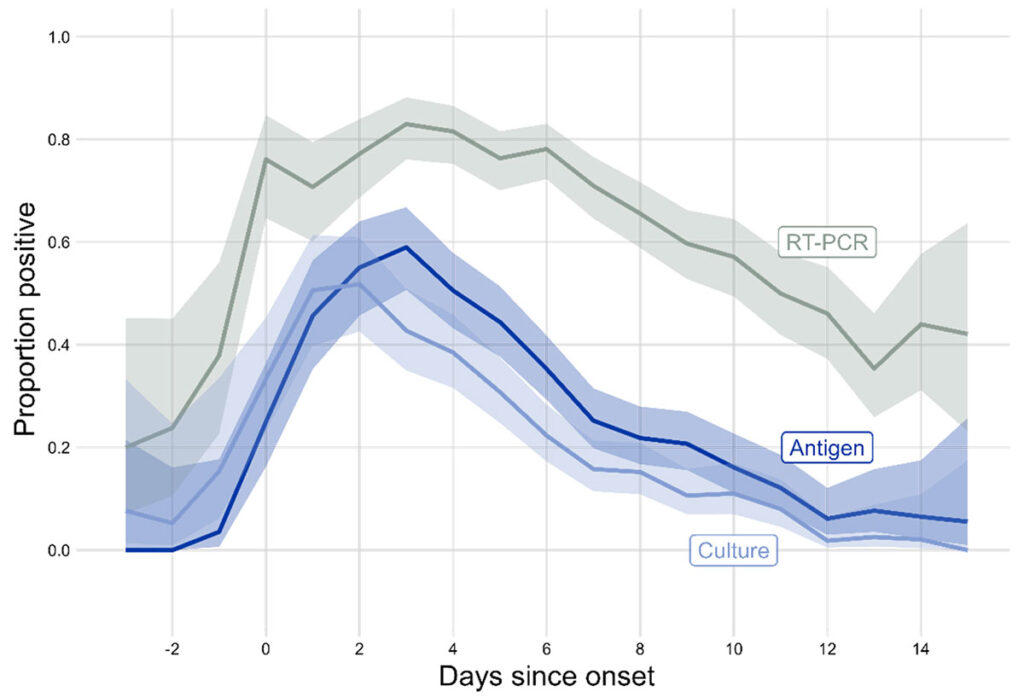A: If you can stay home for a few days when you are sick, you should. If you test positive for COVID, isolating until you test negative is safest. If you can’t, wear a high quality mask and do your best to minimize your exposure to others.
The US CDC recently updated their guidance to simplify recommendations for preventing spread of all respiratory pathogens, ending specific guidance for COVID-19 nearly four years after the start of the pandemic.

Source: CDC
Some people have had strong feelings about this new guidance. The primary concern was the change to isolation guidance for COVID-19. Previously, the CDC recommended staying home for at least 5 days after symptom onset or a positive COVID test, with 5 additional days of precautions such as masking (and earlier in the pandemic the recommendation was 10 days of isolation). The updated guidance moves to symptom-based criteria, recommending people stay home until symptoms are improving for at least 24 hours, including being fever-free without medications.
The benefit of this recommendation is that it applies to someone with symptoms of any respiratory illness, including common colds, flu, and RSV, for which there are generally no home tests. Most people have no idea which virus they have, and a negative COVID test can sometimes backfire by making people feel safe to be out and about. The downside of the guidance is that symptoms are not a great way to gauge contagiousness with COVID-19 (and probably other infections, but we have less data on that). People with or without symptoms can be contagious for 8-10 days or longer with COVID, but the highest levels of infectiousness are during the first 5-6 days after symptom onset (or first positive test, if asymptomatic):
Highest levels of culture-positive SARS-CoV-2, an indicator of infectiousness, occur in the days around and after symptom onset, with a small proportion of people continuing to have culturable virus beyond one week

Unpublished data from the Respiratory Virus Transmission Network, involving five U.S. sites that enrolled people who tested positive for SARS-CoV-2 and their household contacts during November 2022–May 2023. Onset was defined as first day of symptoms or, if asymptomatic, first positive test. Note that people can have positive PCR tests, which detect viral genetic material, after they are no longer shedding infectious virus, and culture is the best indicator of infectious virus. This figure is similar to one previously published based on data from early 2021, underscoring the overall stability of viral shedding across variants.
Source: CDC
This means that people following the symptom-based guidance could leave isolation while still shedding virus. This is one reason why the CDC advises to 1) wait another 24 hours after symptoms improve and 2) continue to take precautions like masking and distancing for another 5 days. The idea is that this timeline will cover the bulk of the time most people are highly contagious. For people with several days of symptoms, the updated guidance does not differ much from previous recommendations.
Still, we recognize that some feel this guidance treats COVID like just another respiratory virus when it is not. We agree that COVID still merits extra vigilance, especially for those who are at higher risk or interact with more vulnerable people. It is important to note that this guidance is for individuals and DOES NOT apply to healthcare settings including nursing homes, which still maintain stricter guidance for COVID infection control.
What do Those Nerdy Girls think? We empathize with the tightrope public health officials walk to communicate guidance that is simple and clear but nuanced enough to keep people safe.
We see clear benefits to “unified” guidelines that people can turn to for any sniffle, cough, or fever. If more people stay home when sick in general, that is a big win for everyone.
For COVID specifically, people following this guidance would be isolating or taking precautions for the time they are most infectious. This is also a win.
Some people, including many of our readers, prefer to be more cautious about COVID-19. COVID is still more dangerous than other respiratory viruses, even as its severity has declined dramatically in the last 4 years. COVID-19 infections also come with the added risk of long COVID, which is hard to predict and hard to treat. We also do have rapid home tests for COVID-19, an important tool we can continue to use.
The benefits of testing if you have symptoms or after a known exposure are two-fold: 1) knowing you are COVID positive means you can start antiviral treatments like Paxlovid that reduce your risk of severe illness; and 2) maintaining isolation and precautions until you test negative is the best way to ensure you don’t pass your infection along to anyone else.
For this reason, we encourage a more cautious testing-based protocol for leaving COVID isolation for those who are able. This is the protocol many of Those Nerdy Girls follow for themselves and their families. The new CDC guidance includes testing to monitor when you become negative as an option during the 5 days of additional precautions following the “stay home” period.
BUT- we also recognize that staying home for 8-12 days and purchasing lots of rapid tests is a luxury many people don’t have. Life is complicated. Everyone has different risks and trade-offs to consider, and we shouldn’t let the perfect be the enemy of the good. In that spirit, we think the updated CDC guidance is helpful in outlining precautions that apply more generally to all illnesses and are achievable for more people. But if you choose to follow the symptom-based guidelines, we encourage you to take seriously the extra five days of precautions to protect others.
Besides isolation, the new guidelines emphasize an array of infection prevention measures including vaccination, ventilation, masks, and distancing. For those who were skeptical of the new guidance (or anyone), we encourage you to read the extensive background document the CDC produced to explain these updates, including helpful Frequently Asked Questions.
Will the new guidance lead to increases in COVID transmission? Probably not. Several states and countries had already changed their COVID-19 isolation guidance without clear increases in community transmission or hospitalization (e.g. Ontario, Quebec, and British Columbia, Australia, Denmark, France, Norway, California and Oregon). This is likely because guidance is just that- recommendations meant to help people make better decisions for themselves and their families, without any penalties or enforcement. Entering year 5 of the COVID pandemic, this change is unlikely to dramatically shift people’s COVID behaviors either way. But (ever hopeful!), we think it’s possible that having unified guidance about respiratory illnesses could gradually shift norms towards staying home when sick and using prevention measures in ways that have a longer term impact. And we can all do our part to model and support these norms in our families and communities.
Whether you are happy with the guidance or not, it’s clear that a lot of data and careful thought went into developing the recommendations. We know this is a hot topic, so feel free to let us know your thoughts below and/or anything you are struggling with in navigating the new guidance.
Stay safe, stay well,
Those Nerdy Girls


